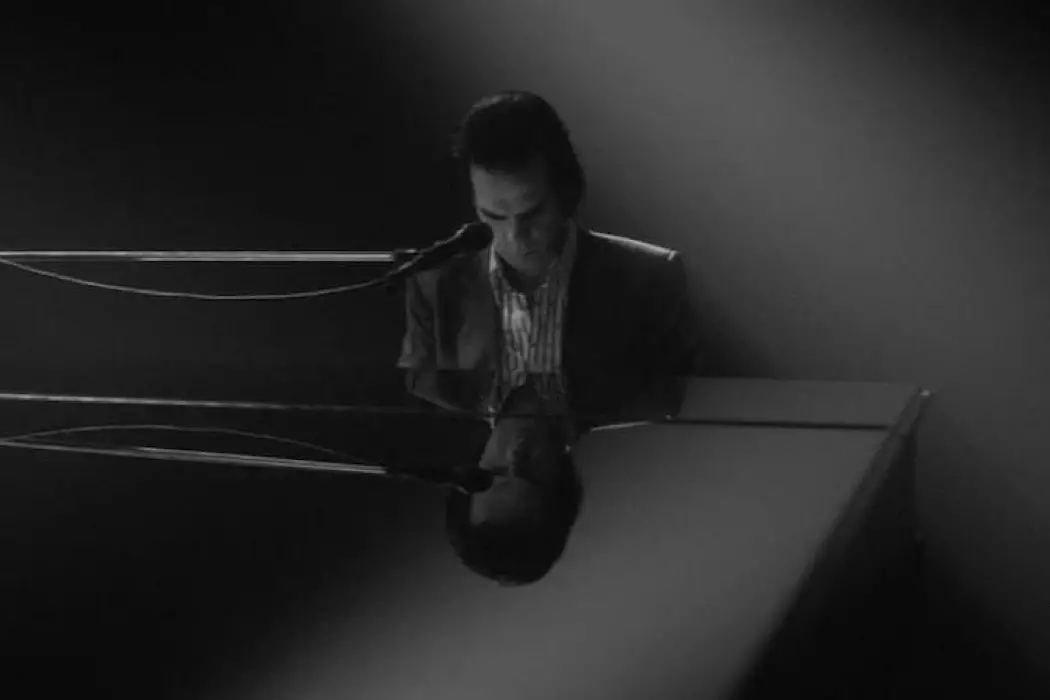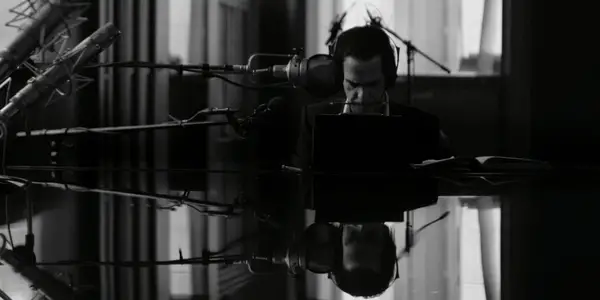ONE MORE TIME WITH FEELING & THIS MUCH I KNOW TO BE TRUE: Play To The Tune Of The Camera

Soham Gadre is a writer/filmmaker in the Washington D.C. area.…
When Stanley Kubrick said that movies should be more like music than fiction, it was a consideration that the movements and formal choreography of a film’s individual elements should coalesce into a symphony. He added, “the theme… the meaning… all of that comes later.” While Andrew Dominik’s narrative films have a distinct story to tell and a clear, wear-it-on-its-sleeve meaning, his two documentary productions with musician Nick Cave function more as hypnotic trance of visual, incandescent composition. Both in black & white and in color, Dominik’s documentaries display an authorial role in creating mood and sensation, an attempt to translate the heart and soul of the subject’s music into its cinematic equivalent.
One More Time with Feeling

The more remarkable of the two docs is the first one, One More Time with Feeling, and not just because of the depth and breadth of its search into the mind and matter of the artist. It was created shortly after the tragic death of Nick Cave’s 15-year-old son Arthur. The documentary hops between places and people circumventing the recording sessions and ultimate release of “The Skeleton Tree”, the sixteenth album by Nick Cave and The Bad Seeds. Thoughts by Cave on the death of his son, thoughts on his family, and the way that death and life both affect his art intersperse studio recordings and practice sessions of songs from the album. His wife, Susie Bick, is also documented and photographed talking about her clothing designs.
One More Time with Feeling gets to some very heavy moments, often displayed as Nick Cave narrating in the stream of consciousness both over scenes of his studio recording and various scenes at a beach, a pier, and the streets of a port town. Shot in stunning digital black and white cinematography and sometimes utilizing 3D cameras, Dominik’s visual approach is that of a painter and musician. He blends shades and cuts the scenes to various musical markers, creating entrancing sequences that double as a music video but also as an engulfing experience in the music itself. There are several tracks building around Cave’s piano that rotate around him like the moon around a planet. Lights explode and burst on and off and the result is surreal – the contrast of brightness and dark voids is both luxurious but also mysterious in its experimentation.
The subject of Cave’s son is always a lingering phantom in the film, though many sequences which deliberately and directly spoke about him in emotional terms were excluded because of concerns they could be exploitative. “It made me feel things that I don’t quite understand,” Cave says about his son’s death. The nature of the documentary to conjure up drama in its subjects is refreshingly avoided in this film. Instead, it enters and sits in Cave’s mind like a quiet observer seeing the lights and shadows twirling and spinning as Cave tries to make sense of everything that has happened to him, his family, and his art.
This Much I Know to Be True
In color, this time, Dominik and Cave’s companion piece This Much I Know to Be True is a quasi-sequel that acts more as a coda to the initial film. It’s much less introspective and almost entirely a catalog of song recordings playing one after another from the latest two Cave/Bad Seeds albums, “Ghosteen” and “Carnage”. This one too is contextualized by the death of another of Cave’s children, Jethro at age 30, but the death occurred after the film had already finished. The tragedy of losing two children makes this one a hard watch just from the knowledge of its occurrence juxtaposed with the jubilance and soul of the music and the film’s accompanying visuals.

Many of the same techniques are employed here by Dominik but the look of a music video is more apparent. Also, less obvious is the introspective elements, most of which come from the beginning sequence of Cave introducing the clay sculptures that he designed, based on Victorian era sculptures he collected. The series, a fascinating fantastical side-project for the musician, is about the life of the Devil. Each sculpture pertains to a section of his life from childhood to adulthood and beyond. The sequence continues one after the other, but the camera makes a significant stop at the sculpture depicting the Devil killing his first-born child. The connection is obvious and Dominik observes the details of that particular sculpture – the position of the child’s head, the Devil holding it up, then Cave silently looking at it.
The studio recording sessions are well directed and there is an added collaborative element with many new and additional members including background singers, helpers, COVID protocol people, and others who bring a larger scope to the whole production. This film is more of a “concert movie” than the previous one and while that’s a downgrade for me – I like more introspective and meditative docs about music that focus on the artist’s brain and soul more than the output – it still features some dazzling camerawork, light shows, and the music is absorbing and dances seamlessly in ballet with Dominik’s direction.
Conclusion:
If there’s one thing to take away from the Dominik/Cave collaborations it’s that these two are artists who have a genuine appreciation for what the other does. There are of course frustrating moments with Dominik wanting or needing Cave to do multiple takes because the camera is out of focus, but this organic aspect of profiling an artist is never hidden or washed over. As polished as the final products of these films are, they are also raw and rustic in their conception… they don’t glaze over or sensationalize anything about the music or the artist. They let the fundamental elements of two modes of art talk to each other, and in turn, talk to us.
One More Time with Feeling and This Much I Know To Be True are both streaming on MUBI for U.S. audiences
Does content like this matter to you?
Become a Member and support film journalism. Unlock access to all of Film Inquiry`s great articles. Join a community of like-minded readers who are passionate about cinema - get access to our private members Network, give back to independent filmmakers, and more.
Soham Gadre is a writer/filmmaker in the Washington D.C. area. He has written for Hyperallergic, MUBI Notebook, Popula, Vague Visages, and Bustle among others. He also works full-time for an environmental non-profit and is a screener for the Environmental Film Festival. Outside of film, he is a Chicago Bulls fan and frequenter of gastropubs.












